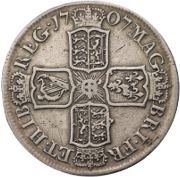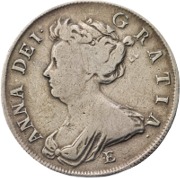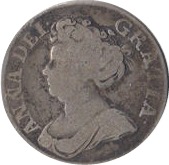
 The 1707 HalfCrown - Queen Anne
The 1707 HalfCrown - Queen AnneThere are a number of variations of the 1707 halfcrown. This one was minted after Union with Scotland (which was in 1707) and carries an 'E' below the bust indicating this is an Edinburgh coin and is now part of the coinage of Great Britain. It is fine (.999) silver. SCBC 3605.
The Reverse is a crowned cruciform shield by Johann Ochs.
The edge shows the regnal year in Latin. In 1707 halfcrown this could be SEXTO or SEPTIMO. The Septimo one is much more expensive.
 The Obverse of the 1707 halfcrown shows a draped bust portrait of Queen Anne by John Crocker. The 'E' below is for Edinburgh.
The Obverse of the 1707 halfcrown shows a draped bust portrait of Queen Anne by John Crocker. The 'E' below is for Edinburgh.Image Credit: The Royal Mint.
Mintage: Not known
Minted at The Royal Mint
More information (monarch, year, mint, country, category) can be found below coin listings.
Below are some coins currently being offered on eBay. As an eBay Partner, We may be compensated if you make a purchase.
List items on:
List items on:
Anne (1702-1714)
 Anne became Queen of England, Scotland and Ireland on 8 March 1702. On 1 May 1707, under the Acts of Union, two of her realms, the kingdoms of England and Scotland, united as a single sovereign state known as Great Britain. Some of these post-Union coins have an 'E' below the bust for Edinbugh Mint.
Anne became Queen of England, Scotland and Ireland on 8 March 1702. On 1 May 1707, under the Acts of Union, two of her realms, the kingdoms of England and Scotland, united as a single sovereign state known as Great Britain. Some of these post-Union coins have an 'E' below the bust for Edinbugh Mint.Born Anne Stuart, the daughter of James II, she became Queen after the death of William III. Anne was the last of the Stuarts and became the first monarch of the newly formed United Kingdom of Great Britain.
Some coins have "VIGO" on them, meaning they were minted from bullion captured from the Spanish fleet at Vigo Bay. They can be quite rare and expensive.
The regnal years for Queen Anne coins were:
1703:SECVNDO; 1705:QVARTO; 1706:QVINTO; 1709:OCTAVO; 1711:DECIMO; 1713:DVODECIMO; 1714:DECIMO TERTIO.
Category: Half-Crowns
The half crown was a British coin which was valued at "2/6" (two shilling and sixpence) – 12½ pence in modern currency. It was literally half the value of the Crown.Half crowns were first issued around 1549 in gold or silver. It was then issued by the majority of Monarchs (plus Oliver Cromwell) all the way through to Elizabeth II. The last standard mintage was in 1967 and the coin was officially demonetised in 1970, one year before full decimalisation. A proof half crown was released in 1970.
The halfcrown was a large coin, from 1816 to it’s final minting having a diameter of 32mm and weight of 14.1g. In pre-decimalised Britain when the Crown was essentially a commemorative coin, the half crown was the largest denomination coin in circulation and had considerable spending power.
Before 1920, half crowns were actual sterling (92.5%) silver. This was reduced to 50% silver and in 1947 no silver at all was used and cupro-nickel became standard.
Half crowns are beautiful coins to collect and due to their long history they are very popular. As pre-1920 coins are 92.5% silver even worn copies will have the intrinsic price of the metal but they are still very affordable to most people.
Which Mint: The Royal Mint
The Royal Mint is the designated place for the UK to mint coins. It dates back well over 1000 years and is a Government-owned company. Formed in the reign of Alfred the Great about the year 886, during the period 1279-1812 it was generally referred to as The Tower Mint as it was housed at the Tower of London. The Master of The Royal Mint has included famous figures such as Sir Isaac Newton.
Since 2010 it has operated as Royal Mint Ltd, a company owned by HM Treasury, under an exclusive contract to supply all coinage for the UK although it also produces medals and coins for other countries. It is currently located at Llantrisant, Wales.
Country of Origin: United Kingdom
The United Kingdom (UK) is the Union of England, Scotland, Wales and Northern Ireland. It is often refered to as Great Britain (GBR). It has a long, rich history. The orignal coinage was Pounds, Shillings and Pence but since decimalisation on 15 February 1971, it is £1 = 100p, that is One Pound = 100 pence. The coinage of the UK is also a long history, the Royal Mint being established as long ago as 886AD when coins were hammered. Today there is perhaps 30 billion coins in circulation, and many (numismatic) collectors coins and sets are issued frequently in gold, silver and other metals.
Try the Half-Crowns page on eBay UK
As an eBay Partner, We may be compensated if you make a purchase.
As an eBay Partner, We may be compensated if you make a purchase.








